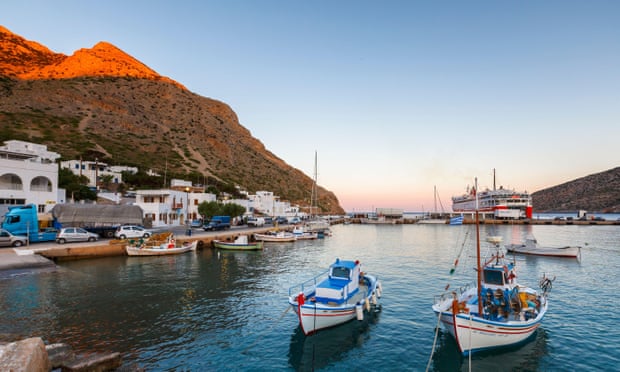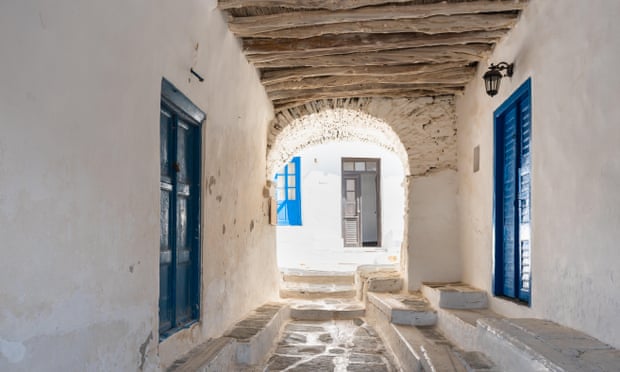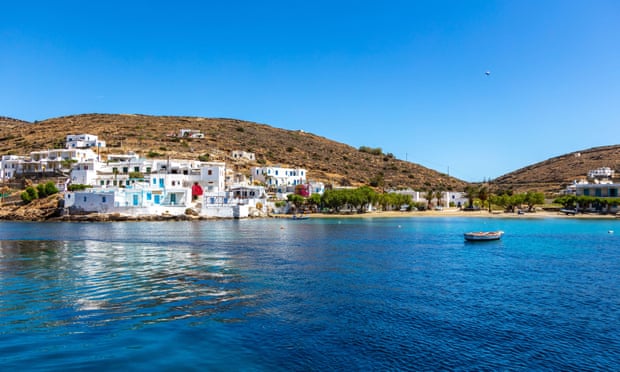
Beauty is all around us on the bright April morning my daughter and I climb a path marked as a donkey trail on our map of the Cycladic island of Sifnos. Butterflies flit over terraced meadows brimming with wild lupins, red poppies, and soft, green grasses. A whitewashed chapel is luminous against the blue sky. Over on a hilltop stand the silver canopy of an olive grove and the remains of a stone windmill, spokes and sails long absent. We approach the edge of a rocky outcrop and a mosaic of blues emerges beneath us: it’s the Myrtoan Sea and it stretches, glittering, in three directions, as if to the earth’s very ends.
Our trail is well marked. Still, we hesitate when we see that it crosses a farmer’s field and, along with it, the herd of cows that he’s shepherding toward a stone outbuilding. “Come on,” he shouts to us in Greek, smiling as he encourages us to follow the footpath across his land. He greets us warmly, asks if we’re having a good walk, then carries on with his work.
From there, we amble through another flower-filled meadow, then switchback down to the picturesque village of Faros, a cluster of white cubic houses hugging a bay. Once the island’s main port, Faros is quiet today, so we continue walking to the beaches of Vlicho and Apokofto and, our destination, the 16th-century monastery of Chryssopigi. Sitting at the end of a rocky islet divided from Sifnos by a narrow chasm spanned by a short footbridge, the monastery stands proud and white against the sea.
Drawn by Sifnos’s 100km network of trails, we’ve come to the island to walk. Today’s path began in the exquisite hilltop village of Kastro, where an Airbnb rental serves as our base for daily adventures. A fortified medieval settlement built as a labyrinth around a 6th-century BC acropolis, Kastro has been continuously inhabited since the third millennium BC and was the island’s capital until 1836, but – as in Faros – inhabitants seem few during these quiet days before the Orthodox Easter. Each morning as we set out, we’re greeted by a chorus of songbirds, roosters and mourning doves, the distant tinkling of goats’ bells, and the mewing of cats who have learned that we will gladly dispense affection along with small bites of food. The people we see on Kastro’s narrow cobbled streets, accessible only by foot, can be counted on two hands: an older woman clad in black who never fails to bid us good morning, the village priest who teaches violin and lute down the alley from our accommodation, a street sweeper, and a handful of tourists who, like us, are here to walk.
Kastro is like a living museum, with sarcophagi and other antiquities scattered in the streets, yet its cafes and tavernas are shuttered at this time of year. There aren’t enough locals to warrant keeping them open year-round, and there aren’t enough tourists either. Most of Kastro’s businesses will open for Easter weekend and then close again until peak season in July and August.

But, slowly, the trails are changing the feast-and-famine nature of tourism on Sifnos, says Moscha Diareme, owner of the Nymfes Hotel in the port town of Kamares. “More and more people are travelling here because of the footpaths,” she says. “They arrive in September, after the peak season ends, and they keep coming through June, until it gets too hot to walk and the hotels fill with the other tourists. For the people who come for the beaches, there’s nothing to do here for nine or 10 months of the year. But for people like you, there’s beautiful walking almost all year long.”
Diareme noticed the increase in walking-based tourism in 2017. “That year, plus 2018 and 2019, were good years because of the walkers. They’re quiet people, but they still like to wake up in a nice place and eat a good breakfast. When they’re done walking for the day, they still like to relax, go for dinner, and shop. Around here we say, ‘If we have more boats, we have more work.’ Now, because of the walkers, we have more boats – during the off-season. The walkers are extending our tourist season; they’re growing our economy.”

As a result, she says, more young people are staying on Sifnos and others, without family connections to the island, are moving here, drawn by the changing economics.
Anna Graikou is one of those young people. Born in Thessaloniki, on the mainland, she visited Sifnos in her early 20s. An avid walker, she was captivated by the island and its trails – and stayed. Today she owns and runs a guiding company, Sifnos Hiking. “In a single walk, you can see a Mycenaean acropolis, falcons, eagles and rare flower and tree species. You’re accompanied by the smells of oregano, thyme, savory and sage.”
As with so many we’ve met here, Graikou’s love for Sifnos is infectious.
The footpaths have always been here, Graikou says. Before roads were built and cars became commonplace, Sifnians used them to travel from village to village, reach the island’s many chapels and churches, and get to their fields. Over the decades, as young people left farming for work in the island’s growing tourist economy, or left the island altogether, many of the pathways fell into disrepair. Few were ever consistently marked or properly mapped.

In 2015, the island’s municipality decided to invest in the trails and promote them to tourists. But first, they had to repair, waymark and map them. For help, they turned to an organisation called Paths of Greece.
Founded in 2010 by Fivos Tsaravopoulos, Paths of Greece works to develop trail networks throughout the country. Tsaravopoulos traces the organisation’s beginnings to 2008 and the island of Kythera, off the southern tip of the Peloponnese peninsula. When he visited to hike the island’s historic pathways, he found many of them neglected and overgrown. “It occurred to me that a vital part of Kythera’s history was disappearing along with the trails,” he says.
He approached the Kytherian Foundation for Culture and Development about restoring them. Since then, more than €140,000 has been invested in the island’s pathways. As Tsaravopoulos worked to help Kytherians revitalise their paths, it struck him that myriad ancient trails exist all over Greece and, if developed, could attract hikers and generate a steady, sustainable source of income for rural communities.

A study by the Kytherian Foundation showed from 2012 to 2016 the island’s trails generated €1.8m in off-season revenue. “Wherever they are, trail networks stabilise the seasonality of traditional, mass tourism,” says Tsaravopoulos. “People don’t come to walk in summer; they come during the off-season.”
Moreover, says Rigas Zafeiriou, programme director for the Kytherian Foundation, walking-based tourism generates money that stays in the community. “We’re seeing that local, family-owned businesses profit from the trails, whereas, for example, package tours, all-inclusive resorts, and cruise ships typically offer fewer benefits to locally owned businesses.”
The challenges created by mass tourism aren’t limited to economics, Zafeiriou adds, especially given the climate crisis. “Suddenly, instead of 3,000 inhabitants, you have 25,000 and all need a shower and access to potable water. By spreading tourism across the year, we normalise water consumption, and we make better use of existing infrastructure, like hotels and restaurants. To further develop peak-season tourism, you’d need to build more infrastructure. This increases carbon emissions and can result in urban sprawl. We want to reduce emissions and prevent sprawl. The trails help us do all of that.”
On Sifnos, Paths of Greece worked with the municipality, local people and volunteers to survey, waymark, and rebuild a network of 19 trails. While community interest is vital to the success of each trail project, Tsaravopoulos says, sometimes he’s initially met with scepticism. “Thankfully, it doesn’t last. When locals see people travelling to their region to walk the trails of their ancestors, they’re inspired to walk them too.” Today, hiking clubs have formed on both Sifnos and Kythera; members gather routinely to walk and help maintain the trail systems.

Despite the quiet in Kastro, there is life on the island during the week my daughter and I are there. For dinner, we often drive our rental car to the towns of Apollonia or Artemonas which has a solid base of year-round residents, and restaurants, bakeries, and shops are open for business. Our favourite taverna is in Kamares where we also like a shop that sells local honey, sweets, and ceramics. Everywhere we go on Sifnos, waymarked trails cross roads and villages, and we see and meet tourists who are here to explore them.
During our walk back to Kastro from Chryssopigi monastery, on the trail marked as a donkey path, my daughter and I do indeed see a donkey, and a white-haired man riding it. Within moments, because this is Greece where people are as warm as the sun, we learn that the 78-year-old travels this path daily to check on his sheep, tend his olive grove and visit a chapel.
“I’ve walked this path nearly every day since I was a little boy,” he tells us when I ask him about the island’s trails. “The paths give us olives, they give us milk, cheese, they give us God – and they give us beauty,” he adds, gesturing at the sea. He asks me pointedly, “Do you agree?”
I nod enthusiastically. “Oh, yes. Yes, I do,” I say.
Visit pathsofgreece.gr, sifnostrails.com and kytheratrails.gr


